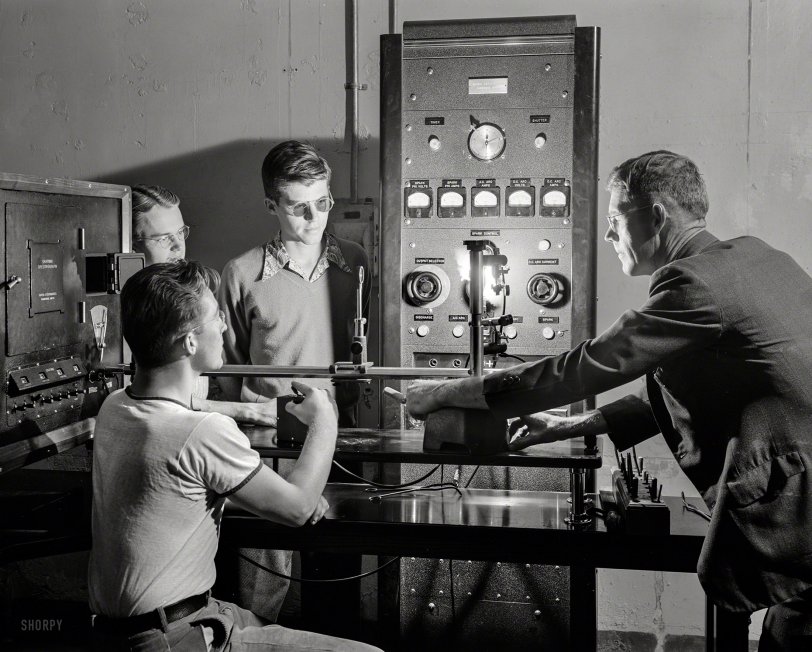


Framed or unframed, desk size to sofa size, printed by us in Arizona and Alabama since 2007. Explore now.
Shorpy is funded by you. Patreon contributors get an ad-free experience.
Learn more.

- Baldwin 62303
- Baldwin VO-1000
- Cold
- No expense spared
- Tough Guys
- Lost in Toyland
- And without gloves
- If I were a blindfolded time traveler
- Smoke Consumer Also Cooks
- Oh that stove!
- Possibly still there?
- What?!?
- $100 Reward
- Freeze Frame
- Texas Flyer wanted
- Just a Year Too Soon
- WWII -- Replacing men with women at the railroad crossing.
- Yes, Icing
- You kids drive me nuts!
- NOT An Easy Job
- I wonder
- Just add window boxes
- Icing Platform?
- Indiana Harbor Belt abides
- Freezing haze
- Corrections (for those who care)
- C&NW at Nelson
- Fallen Flags
- A dangerous job made worse
- Water Stop
Print Emporium
Golden Boys: 1942

October 1942. State School of Mines in Golden, Colorado. "Speed in metallurgical analysis, to match the rapidity with which the nation arms itself, is possible through use of the spectrograph, a marvelous new machine used for study of materials through measurements of the arc of light they emit when heated. The aluminum and magnesium industries, steel companies and foundries use it for quick study of metals. Mines use it for exploration. The spectrograph will yield an analysis of seven elements in 15 minutes, which would require up to four hours by old chemical methods. Students in defense training courses at a famous mining-engineering school listen as an instructor shows them how the machine operates." Photo by Andreas Feininger, Office of War Information. View full size.
Baird Associates Grating Spectrometer
I love this photo, partly because I have personal experience working with a grating spectrometer of similar vintage. I’ll try to give an overview of what is going on in the photo but if someone knows more, please chime in.
On the right, the sample is being heated by high voltage to the point where it is glowing. The emitted light is focused by the lens in the middle onto the aperture of the spectrometer, which is mostly located off-camera to the left: Baird spectrometers, manufactured in Cambridge, MA, were 3 meter long boxes. Only the front face of this box is visible in the photo. The light enters at the front end and travels the length of the box. At the far end is a mirrored surface scored with thousands of fine parallel lines (the grating), positioned on a platform which can be rotated to alter the angle of incident light. The grating breaks the light into different wavelengths similar to the effect of prism. The reflected light returns as a rainbow to the front of the spectrometer where it can either be visually examined or directed towards some type of photo-dectector for more quantitive analysis. I’m not sure what type of detector they would have been using here but the hinged door on the front of the spectrometer would have allowed access. Perhaps they used photographic plates. In any case, by slowly rotating the grating, perhaps using the controls along the bottom of the spectrometer face, different wavelengths of light are cast onto the detector allowing the users to measure the spectral peaks and valleys which uniquely identify the different elements. Gratings were used instead of prisms because they could be more precisely calibrated. Likewise, the large size of the spectrometer, 3 meters long, was necessary at the time to achieve high resolution to discriminate between closely spaced lines in the light spectrum. I’m a little confused by the aperture where the light enters the spectrometer. Normally this would be a fine slit but that is not visible. Perhaps the screen just above the man’s head was used to focus the light and then could be swung out of the way to reveal the slit. The fellows appear far more fixated on the heated sample rather than the operations of the spectrometer.
Great school!
The Colorado School of Mines in Golden is one of the best engineering schools in the country. Golden, just outside Denver, is also the home of Coors beer and close to Red Rocks Amphitheater, the most awesome concert venue in the country. All of this spells a great college experience for any young man or woman with the bona fides to be accepted there.
Golden Guys
The photograph is reminiscent of the Thomas Dolby cover album "The Age of the Golden Wireless."
Size matters, guys.
Yet another gadget that has gone to desktop size and below over the years.
Moore's Law at work, probably.
























On Shorpy:
Today’s Top 5